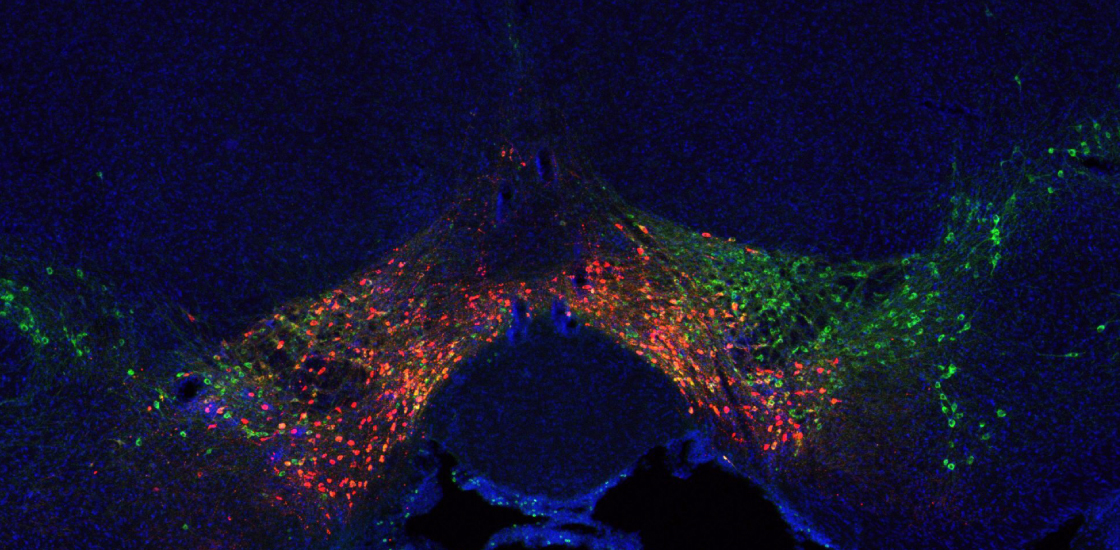Mice that sleep poorly for a short period in early life grow up to have altered brain activity and atypical social behaviors as adults, according to new research. The findings may help explain the link between sleep difficulties and autism, the researchers say.
Many autistic people have trouble falling and staying asleep. But whether those difficulties stem from or contribute to autism traits — such as sensory sensitivities and social difficulties — has been unclear.
The new study supports the latter possibility — that sleep problems early in life shape some aspects of social behavior. Disrupting the animals’ non-rapid eye movement (non-REM) sleep, the component thought to be necessary for survival, for just five days during their first two months of life leads to long-term changes in behavior and in how dopamine is released in a social region of the brain, the study shows.
“The point that we’re trying to make is that imbalances in excitability — in neuromodulators, in particular — can have very significant consequences later in life,” says lead researcher Luis de Lecea, professor of psychiatry and behavioral sciences at Stanford University in California.
Male mice that lack the autism-linked gene SHANK3 have similarly atypical social behaviors when they lose sleep, past research has shown. And those that harbor a SHANK3 mutation found in some people with autism have the same behaviors and brain connectivity seen in sleep-disrupted mice, de Lecea and his colleagues found. Dampening the activity of neurons in the affected brain region or improving the animals’ sleep when they are young makes those traits more typical in adulthood.
“When they improve non-REM sleep, they can improve social functioning,” says Lucia Peixoto, assistant professor of biomedical sciences at Washington State University Spokane, who was not involved in the study. “This argues for a causal role of non-REM sleep in development on one of the core symptoms of autism.”
W
hen the mice were 35 to 42 days old, the mouse equivalent of mid-adolescence, de Lecea and his colleagues disrupted the animals’ sleep by programming a moving platform to periodically shake their cages for four hours a day for five consecutive days. The shaking did not elicit a stress response, based on the animals’ blood levels of the stress hormone corticosterone, but the mice did not sleep during those four hours, electroencephalography (EEG) recordings showed.As 56-day-old adults, the sleep-disrupted mice still socialized with other mice and had no apparent memory deficits. But unlike controls, they strongly preferred to spend time with familiar, rather than unfamiliar, mice.
The researchers linked this change to atypical activity between the animals’ ventral tegmental area (VTA) and nucleus accumbens, two brain regions involved in social behavior and reward.
During an encounter with a novel mouse, control mice experienced a flood of dopamine from the VTA into the nucleus accumbens, de Lecea and his colleagues found using a fluorescent dopamine sensor. The amount of dopamine released diminished with each meeting, which may explain why wildtype mice tend to prefer to interact with a new mouse, the researchers say.
For mice that experienced sleep deprivation during adolescence, however, the amount of dopamine released did not decrease as quickly with subsequent meetings. And when they were introduced to another new mouse, there was no detectable dopamine flood, the team found.
The results suggest that, for the sleep-disrupted mice, “interacting with the novel stranger is not more rewarding than [interacting with] the familiar one,” says study investigator Wenjie Bian, a postdoctoral researcher in de Lecea’s lab.
Using chemogenetic tools, the team overexcited VTA neurons in adolescent control mice and found that it triggered a loss of preference for novel mice, as seen with the SHANK3 mice and the sleep-disrupted mice.
Tamping down the activity of VTA neurons in sleep-disrupted adolescent mice using a similar method normalized their social behaviors, further confirming the circuit’s role. And boosting non-REM sleep in SHANK3 mice using a drug — or optogenetically enhancing the animals’ slow wave activity, a component of non-REM sleep — led to typical social behaviors in the model animals. The findings were published in Nature Neuroscience in May.
D
isrupting sleep in adult mice had no effect on their social novelty preference, the team found, and doing so in 42- to 49-day-old mice had a slightly weaker effect than in younger adolescents. That result suggests that there is a critical window of development during which sleep quality shapes the activity of VTA neurons, Bian says.The team has not yet run the experiment on younger mice because it is difficult to isolate and use EEG on the animals before 35 days of age.
The discovery of a window during which sleep can influence social behavior is exciting because not much is known about such ‘critical periods’ for sleep, says Philippe Mourrain, associate professor of psychiatry and behavioral sciences at Stanford University, who was not involved in this work. “As we sleep every day throughout our lives, it is important to investigate and understand the effects of acute and chronic sleep deficits at different time points across life.”
And because interventions during the critical period have long-lasting effects, he says, “this is one more study showing that there is hope for transient intervention, instead of a lifetime of treatment.”
Such treatments may not yet be available, but the new findings “justify at least initiating clinical trials for sleep intervention in adolescence,” de Lecea says.
“Most clinicians will agree that sleep is a problem” for autistic people, he says, but they may question whether it is worth targeting something like hyperactivity of VTA neurons. “I think the answer is, we might as well try.”





